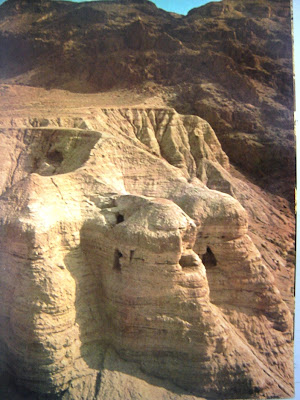Qumran
On the sores of the Dead Sea
The origins of the Jewish community
 |
| Geographical location of Qumran |
By the year 150 B.C. arrived on the shores of the Dead Sea, not farfrom Jericho, a group of pious Jews led by priests who had broken with the Clergy of Jesuralén. Then reigned in Judea the high priestJonathan, a descendant of Mattathias Maccabee, who had been thesoul of the Jewish resistance to the attempted Hellenization ofPalestine held by the Seleucid king Antiochus IV. The dissidents,whom the Jewish historian Josephus gives the name of Essenes,reproached the priest-king of Jerusalem acceptance of Hellenism,with all the dangers of paganism that it implied, and not everdesignated by name, but by the derogatory epithet "wicked priest",contrasting it to his boss and certainly founder, the Teacher of Righteousness.
Gradually, in the desert, the group was organized as a truecommunity of uncompromising faith in a monastic town whose ruinshave been explored by French archaeologists led by Father deVaux. The site, near a water source bears the Arabic name ofQumran.
Notably, the radiant faith from this important Jewish community, hadmany points of contact with Christianity.
Notably, the radiant faith from this important Jewish community, hadmany points of contact with Christianity.
Life in Qumran
The traveler who was host of the Qumran community back in theearly Christian era have been able to visit the room where they metthe Essenes, the scriptorium in which some of them copied theancient biblical books or transcribed his own works, refectory , Kitchen, laundry, bakery, tanks, toilets and cemetery, with gravescovered with stones. A tower was watching this group of buildings.
Flavius Josephus, who certainly had visited the community on the shores of the Dead Sea, writes in his writings how the daily life of his brothers.
"Until the sun rises, do not utter a profane word, and are limited to direct the star traditional prayers, and beseeching him to appear. Then your administrators send everyone to the tasks they know best, and until the fifth hour
Qumran Caves
Where a Bedouin shepherd boy
found the first Dead Sea Scrolls(eleven of our way of telling) work with the greatest ardor. After being reunited, complies linen loincloths and bathe in cold water. After this purification, meet in a private room where you should not get any profane . They themselves did not enter the dining hall, rather than pure, as in a sanctuary. When they are sitting quietly, the baker is distributing the bread in order, and the chef serves a single bowl each with a single box lunch. Before the meal, the priest says a prayer, and nobody is allowed to taste the food before the prayer, and when they have finished eating again to pray. Both the beginning and end, God bless food dispenser that gives life . After leaving the clothes they have been for food, like holy garments, and return to work until dark. Then, back in the hostel common, take the dinner in the same way, and feel your table guests if any step in the casa.Ni a scream, not a home crowd ever desecrated, all speak in turn. For the d out, the silence of those inside it seems a terrible mystery. The cause istheir continued sobriety, and the fact that food and drink they are measured so that they can fill and nothing more. "
As for the other activities of the Essenes, excavations haverevealed the existence of an area reserved for the mill. Two teethwere found intact basalt and two broken, which seems to show that cultivated cereals. The presence of palm-wood beams and bones of dates in the caves and among the ruins indicates that the tree wasthen grown in the region.
Deposits of bones of sacrificial animals from herds certainlysuggest the practice of farming among the inhabitants of Qumran. Craftwork certainly occupied much of the community who just had to spend a hundred people.
Some defects were reserved most noble, as evidenced by the RuleScroll, discovered in one of the caves in 1947. It recommends thestudy of Law:
"That here where people gather ten people do not miss one to studythe Law day and night "...." ensure that the many common during thethird night of the year to read the book, studying the law and blessGod. "
Of those evenings of study peculiar indeed come to Scripturecommentaries found at Qumran. These documents, often Sibyllinespecialists are allowed to reconstruct the outline of the history of thesect and discover its innovations in religion. The Essenes hadreplaced the two daily burnt by the sacrifice of praise.
Held two offices, one in the morning and evening, as witnessed by this passage to the Rule:
"When you arrive the day and night, go into partnership with God.And when they retire at night and morning, tell your precepts ..."
The prayer of the qumraníes fed on traditional biblical psalms, butthe Psalter found in one of the caves contains many that were notin the Bible. In 1947 the first cave appeared in a roll with psalms ofthanksgiving very personal accent, in which a character appearshaunted, probably the Teacher of Righteousness. It is possiblethat, after composing the founder of the sect, some of thesepsalms, was continued by his followers. This was probably theprayer recited by the new recruits to join the Alliance, ie, in the Essene community: "I thank thee, my God, because you wanted to show the creature of clay and how great your power is formidable."Who am I that I have taught the secret of the truth and made knownhis wonderful works? ". This prayer of thanksgiving, which is both a genuine profession of faith was probably recited by new converts to their entry into the community, which took place at Pentecost.

No hay comentarios:
Publicar un comentario